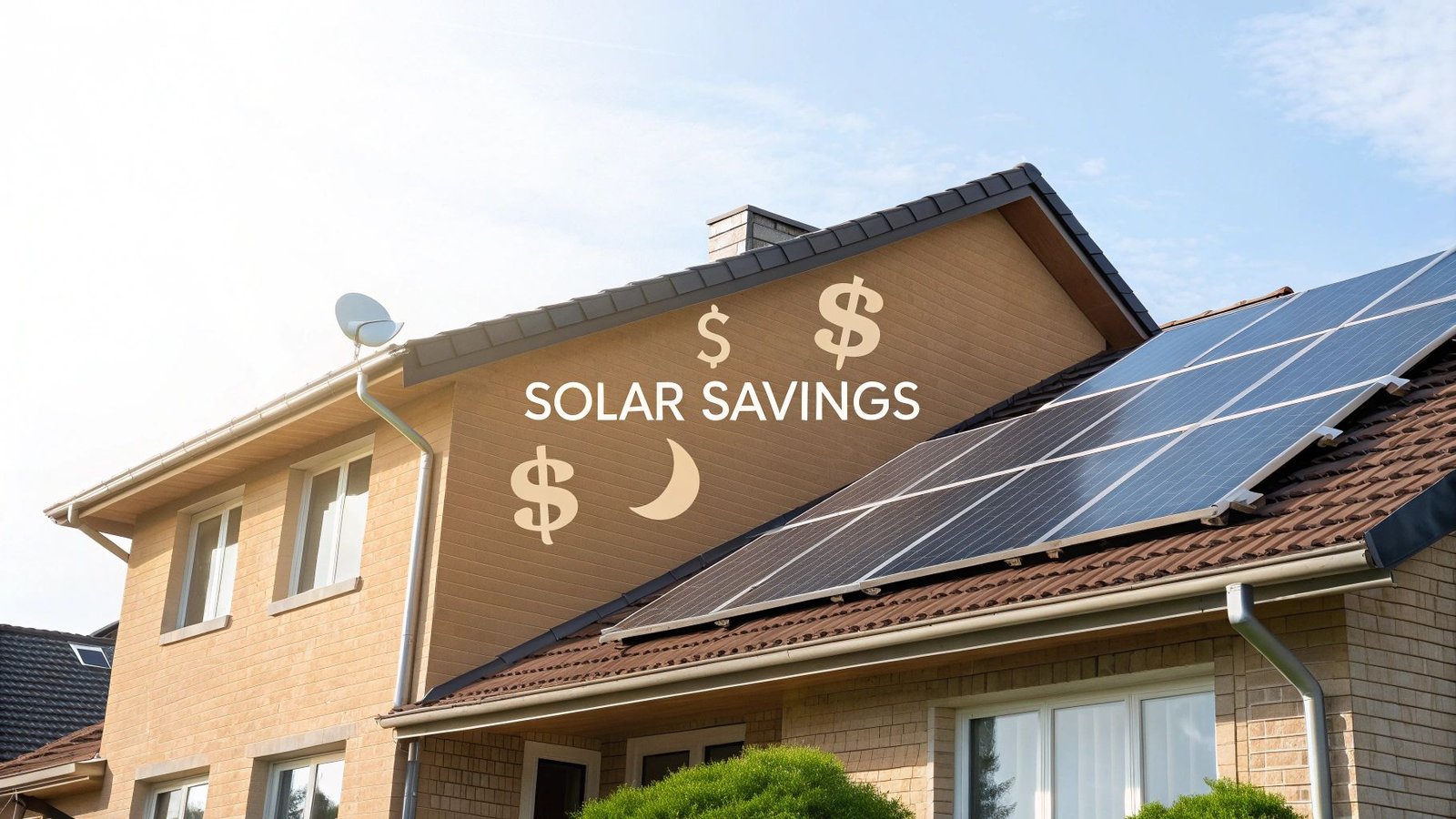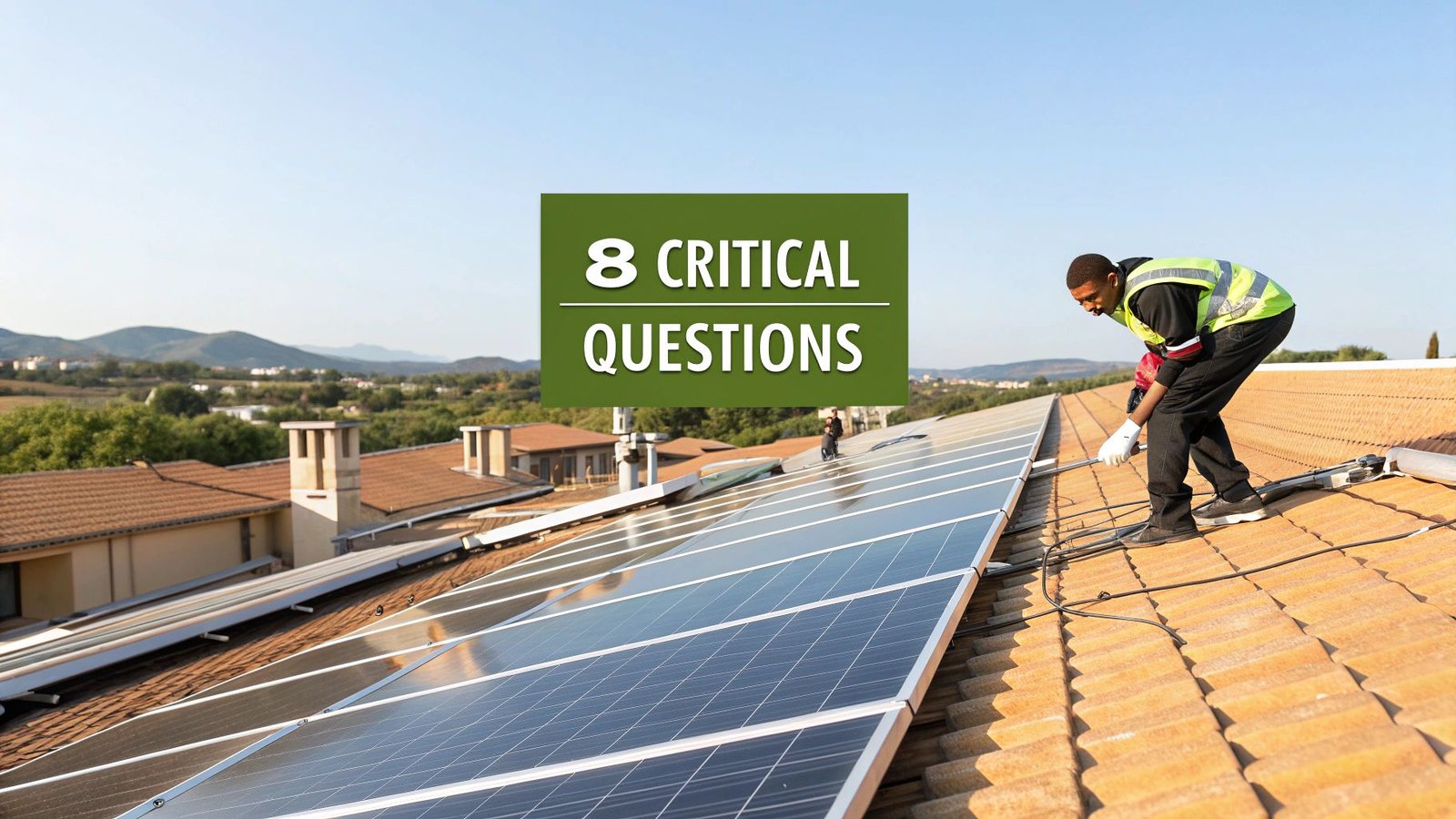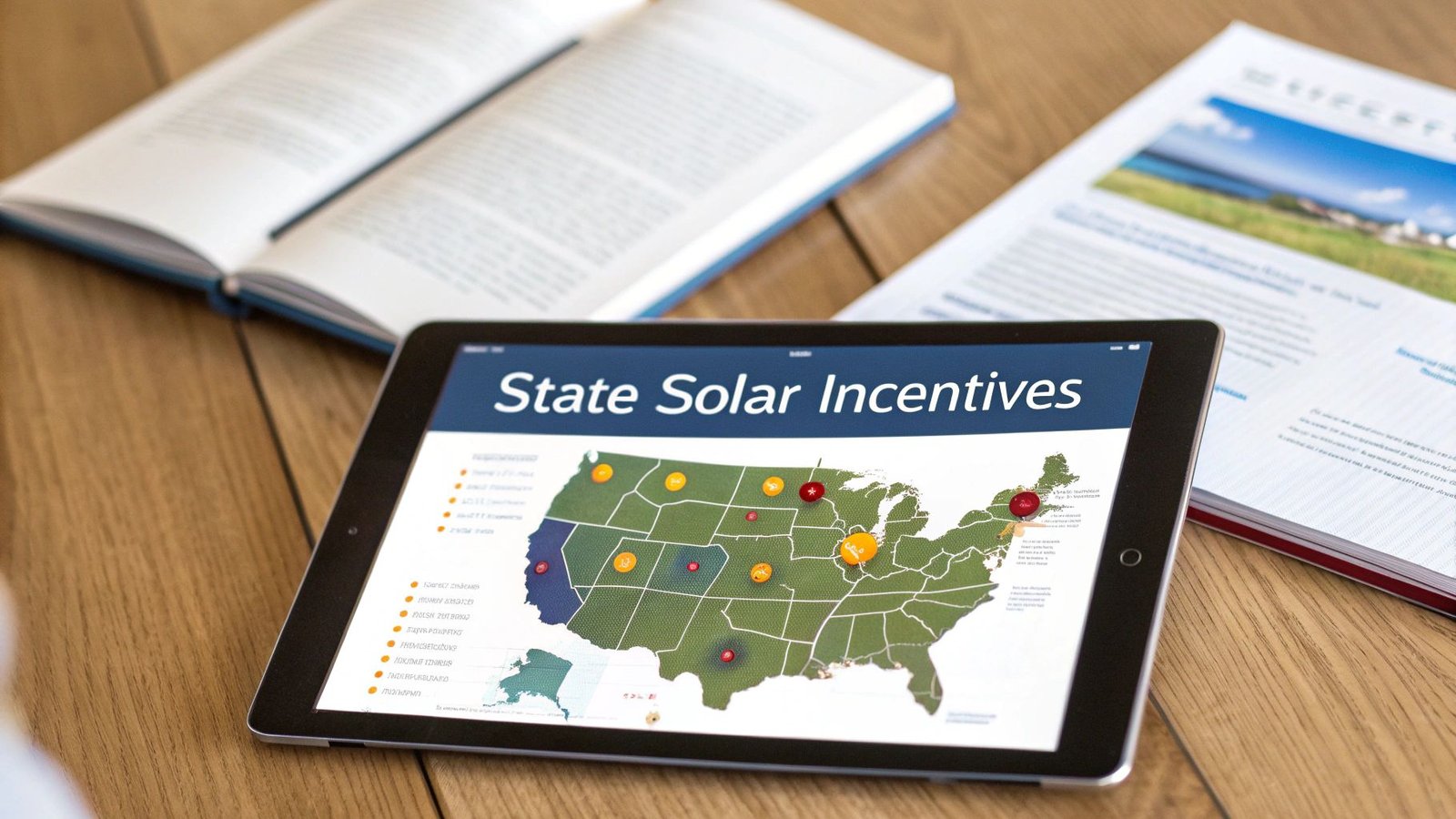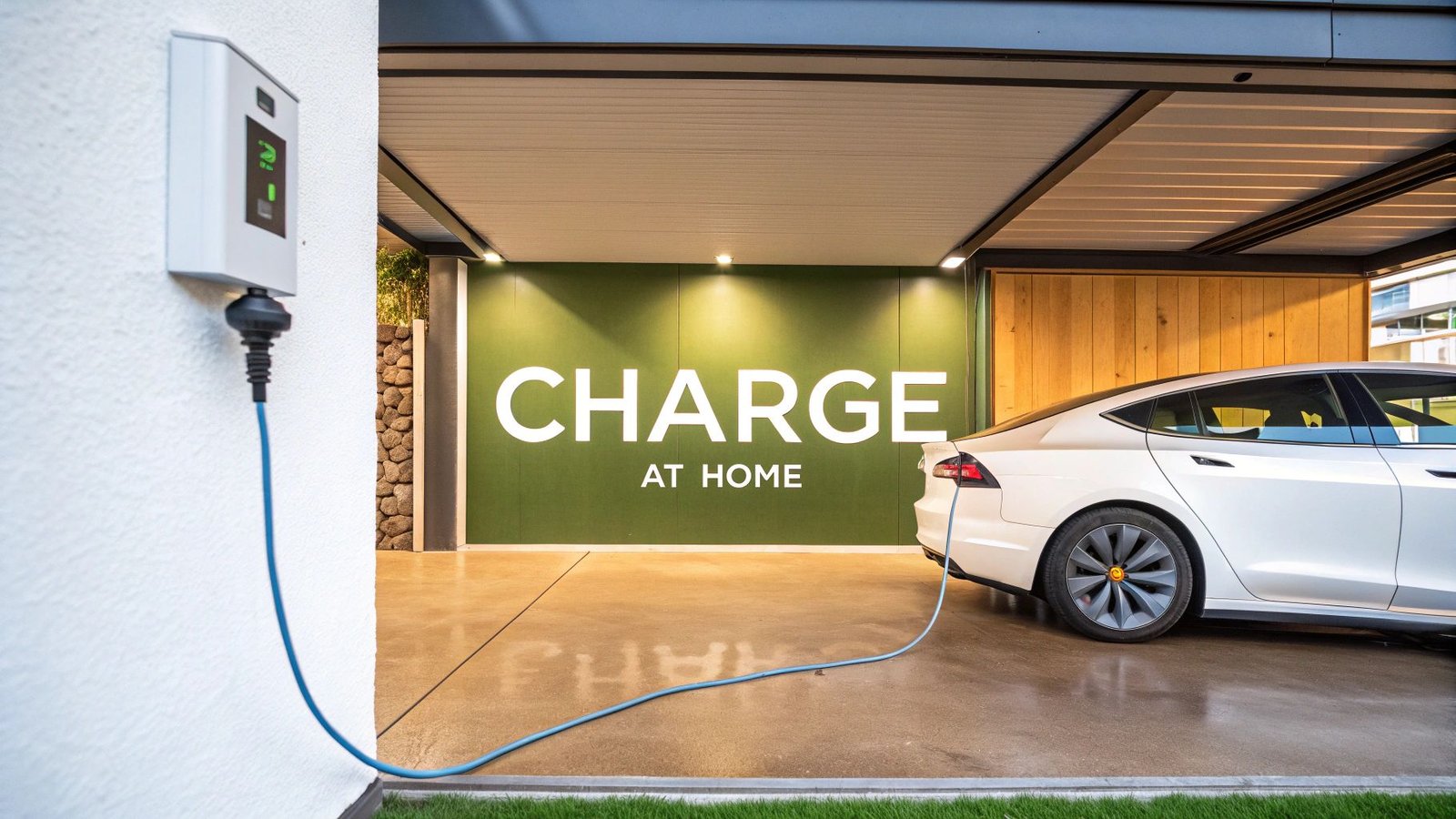Thinking about going solar? The numbers are pretty compelling. On average, you could save around $57,000 over the 25-year lifespan of your system, sometimes much more. It's a significant drop in your energy bills, and for many people, the system pays for itself in under a decade. This makes solar one of the smarter financial decisions a homeowner can make today.
Your Potential Solar Savings At A Glance
Switching to solar impacts your finances right away and continues to deliver value for years to come. It’s not just about a lower monthly bill; it's a complete shift in how you manage your home's energy costs.
Here's a quick look at what you can expect:
- You'll see an immediate drop in your electricity bills the moment your system is turned on.
- The payback period—the time it takes for your savings to cover the initial cost—is often less than 10 years.
- With the right incentives, your lifetime returns can be equivalent to a 20% annualized return on your investment.
- Solar panels are a major upgrade that can significantly increase your home's resale value.
- You gain energy independence and protect yourself from the constant, unpredictable rate hikes from utility companies.
These points provide a great starting point, but the real magic is in the details. Factors like your local utility rates, available incentives, and the size of your system all play a huge role.
Typical Solar Savings Breakdown
To give you a clearer picture, let's break down the typical financial journey of a residential solar installation. The chart below outlines what most homeowners can expect in terms of initial costs, payback time, and total savings over the life of the system.
graph TD
subgraph "Solar Financial Metrics"
A[Initial Investment<br>$10k - $30k] --> B(Payback Period<br>5 - 10 years);
B --> C(Lifetime Savings<br>$37k - $148k);
end
style A fill:#f9f,stroke:#333,stroke-width:2px
style B fill:#bbf,stroke:#333,stroke-width:2px
style C fill:#9f9,stroke:#333,stroke-width:2px
As you can see, while there's an upfront investment, the long-term savings are substantial, making it a powerful financial tool for your household.
Below is a diagram that shows what's going on inside a typical solar panel. It's a fascinating piece of technology.
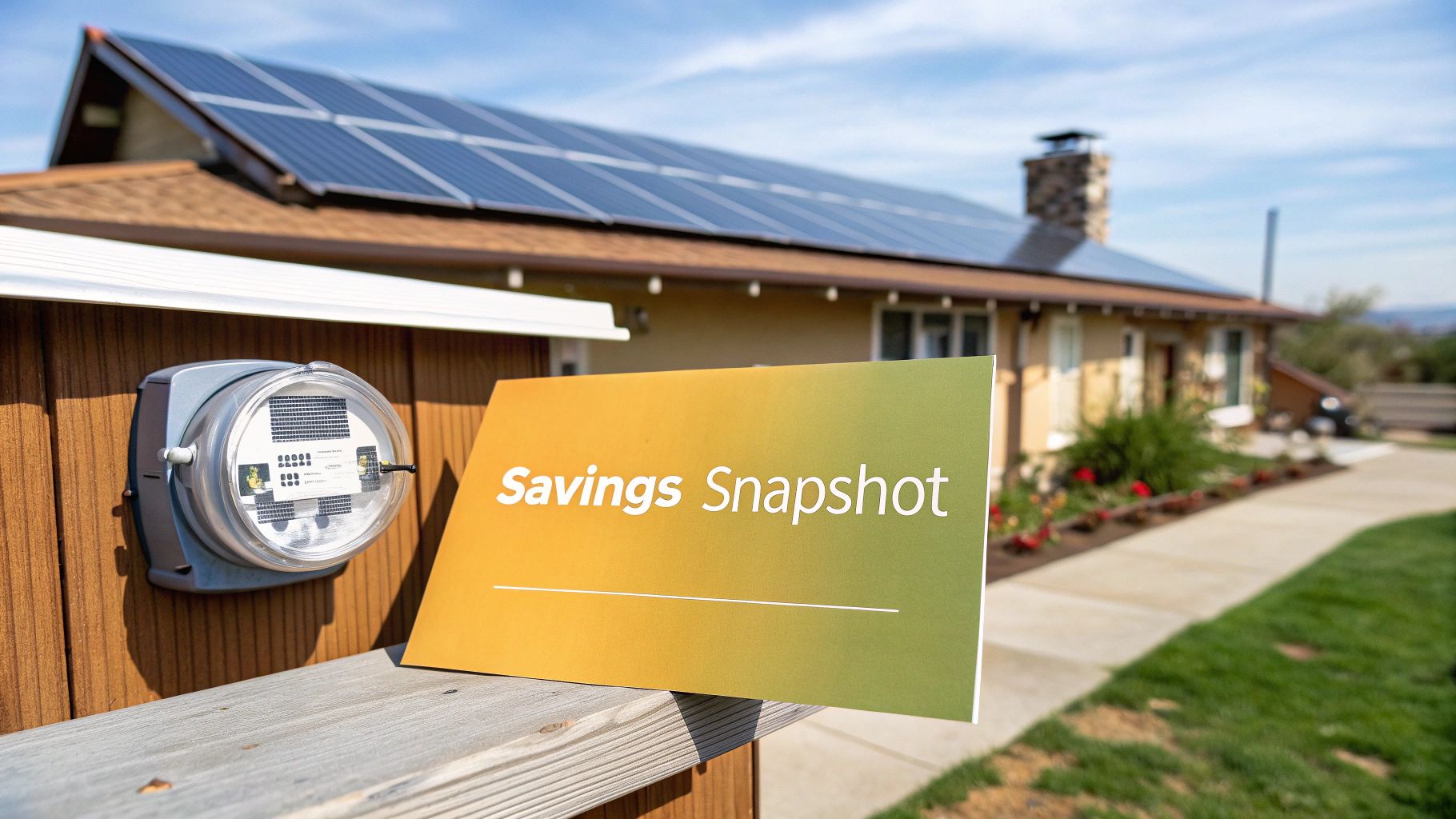
This image breaks down how photovoltaic cells work together to capture sunlight and turn it into usable electricity for your home, illustrating the different layers that make it all happen.
Across the United States, the average homeowner can expect to save about $57,000 over 25 years by installing solar panels. That said, the savings can range anywhere from $37,000 to a whopping $148,000, depending on your local electricity rates, how much sun you get, and the size of your system. You can dig deeper into these figures on the EnergySage solar savings guide.
Key Insights
Key Insight: Most homeowners find that their solar investment pays for itself in under a decade, especially when they can take advantage of net metering programs.
A few things really move the needle on your return on investment:
- The higher your current electricity rates, the faster your payback period will be.
- Bigger solar systems generally have a lower cost-per-watt, improving the overall economics.
- State and federal incentives are designed to shorten your payback period and boost your total savings.
Want to get a more precise estimate for your own home? The best way is to plug your numbers into a calculator. You can check out our solar energy calculator for home to get a personalized projection.
Now that you have a high-level view, let's dive into the specific factors that determine just how much you can save. Up next, we'll walk through how to calculate your own personal payback period.
How Solar Energy Actually Puts Money Back in Your Pocket
Before we jump into the numbers, let's pull back the curtain on how solar panels actually save you money. It’s less like buying a new appliance and more like building a tiny power plant on your roof that prints valuable energy credits instead of sending you bills.
Think of it like this: buying a solar system is a bit like buying a rental property. You make one big investment upfront, but then it generates passive returns for decades to come. Instead of collecting rent checks, you're harvesting sunlight, turning it into electricity, and slashing what you owe your utility company every month.
The Grid: Your Personal Energy Bank
The real secret sauce behind solar savings is a brilliant concept called net metering. The easiest way to understand it is to picture the electrical grid as a giant, shared battery or even a bank account for your power.
Here’s how it works day-to-day:
graph TD
A(Sunny Day) --> B{Solar Panels<br>Generate Excess Power};
B --> C(Excess Power sent to Grid);
C --> D(Utility Company issues Credits);
E(Night/Cloudy Day) --> F{Home<br>Needs Power};
F --> G(Power drawn from Grid);
G --> H(Credits are used to offset cost);
style C fill:#9f9,stroke:#333,stroke-width:2px
style D fill:#9f9,stroke:#333,stroke-width:2px
style H fill:#f99,stroke:#333,stroke-width:2px
-
Making Deposits: On bright, sunny afternoons, your panels will likely churn out more electricity than your home is using. That extra power doesn't just disappear. It flows back into the grid, and your utility company gives you credit for every single kilowatt-hour you contribute.
-
Making Withdrawals: Later, at night or on a cloudy day, your home will pull power from the grid just like it always has. But instead of getting a bill for that electricity, you simply draw from the credits you've already banked.
This back-and-forth system is what allows you to get the full financial benefit from every ray of sun your panels capture. It’s the key to dramatically shrinking, or sometimes completely wiping out, your monthly electric bill.
A well-designed solar system aims to generate enough credits during the day to completely offset your energy use at night and on cloudy days. The ultimate goal is getting your net electricity bill as close to zero as possible.
This isn't some niche technology anymore; it's a mainstream financial tool for homeowners. The global solar market is expected to generate a staggering 1.39 trillion kilowatt-hours of electricity this year alone, driven by dropping installation costs and increasingly powerful panels. You can dive deeper into these solar statistics and see how the trends are benefiting homeowners directly.
Your Payback Period: The Break-Even Point
Finally, let's talk about the payback period. This is simply the time it takes for your total savings on electricity bills to completely cover the initial cost of your solar installation.
Once you cross that finish line, it’s all gravy. Every bit of electricity your system produces for the rest of its 25+ year lifespan is pure profit—free, clean power for your home for decades.
The Key Factors That Determine Your Savings
So, how much money can you actually save with solar? The honest answer is: it depends. There’s no magic number, because your potential savings are shaped by a unique blend of factors specific to your home, your location, and even your lifestyle.
Think of it like a car's fuel efficiency. You know the sticker says "30 MPG," but your actual mileage depends on whether you're cruising on the highway or stuck in city traffic. Solar panels are similar—their performance hinges on real-world conditions.
Getting a handle on these variables is the first step to figuring out what your return on a solar investment will really look like.
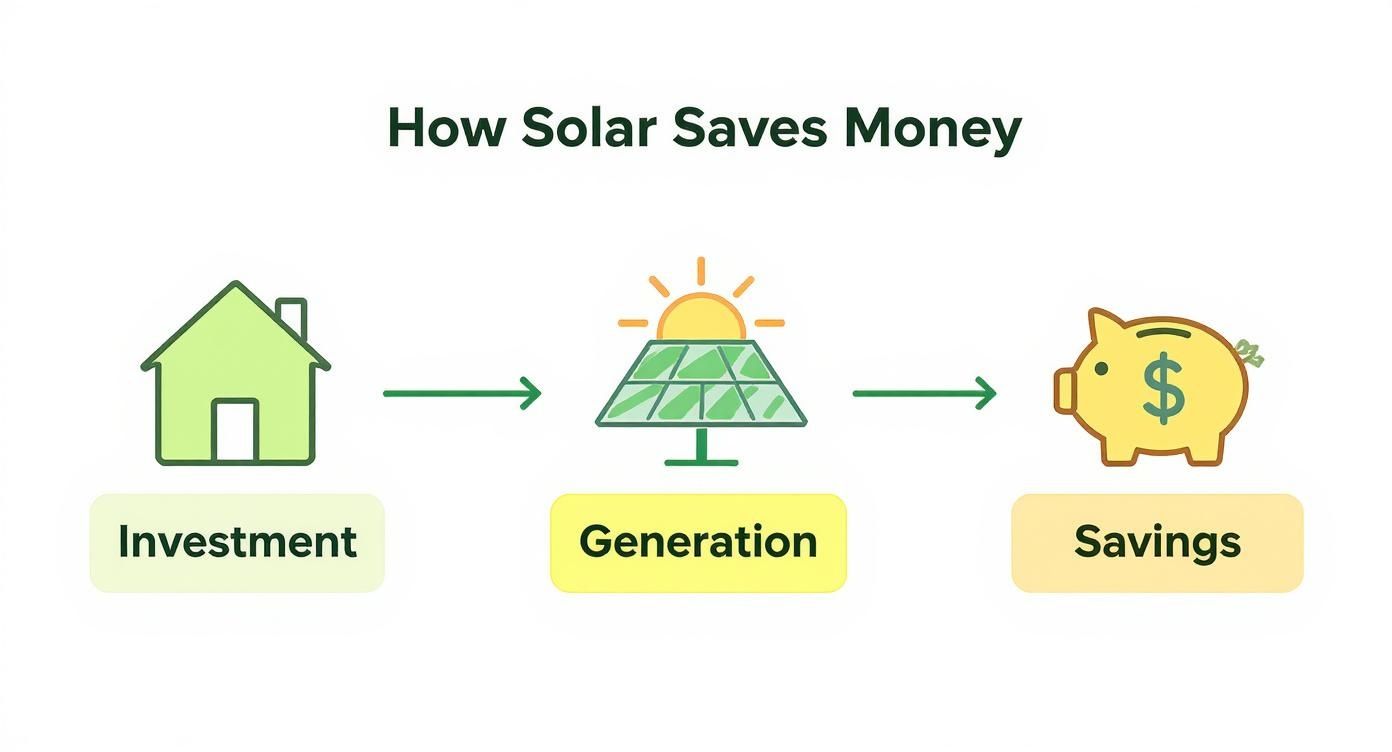
This infographic breaks it down nicely. It shows the journey from your initial investment to generating your own power, which ultimately puts money back in your pocket. The better your system is at converting sunlight into electricity, the faster you'll see those savings stack up.
Your Electricity Rates and Usage
If there's one factor that overshadows all others, it's what you're currently paying for electricity. The math is simple: the higher your utility rates, the more you stand to save.
A solar panel system that saves a homeowner $100 a month in a state with cheap power might save another homeowner $250 a month in a place like California or the Northeast, all for the exact same amount of energy produced. High electric bills are the fuel for a fast solar payback.
Of course, how much power you use matters, too. A large family running multiple appliances and AC units will have a higher bill to offset, so they'll see a more dramatic drop in their monthly expenses after going solar.
Key Takeaway: The higher your current electric bill, the more powerful solar becomes as a financial tool. It directly offsets a major monthly expense, turning a liability into an asset.
And remember, solar panels are just one piece of the puzzle. You can amplify your savings by making your home more efficient overall. For instance, looking into the energy efficiency and cost savings benefits of eco-friendly ceiling fans can help reduce your air conditioning load, letting your solar panels cover even more of your energy needs.
Your Home's Physical Characteristics
When it comes to solar production, not all roofs are created equal. The physical layout and orientation of your home play a massive part in how much sunlight your panels can actually capture.
These are the three big things to consider:
- Roof Direction: In the Northern Hemisphere, a south-facing roof is the gold standard. It gets the most direct sun exposure from morning to evening. East or west-facing roofs still work well, but they might produce a bit less power overall.
- Shading: This is a solar killer. A big oak tree or a neighbor's two-story house casting a shadow over your roof can seriously hamstring your panels' output. Any good installer will conduct a thorough shade analysis to find the sunniest spots.
- Available Space: It’s a simple question of real estate. The amount of clear, unshaded roof space you have dictates the maximum number of panels you can install, which puts a ceiling on your potential energy generation and savings.
Calculating Your Personal Solar Payback
So, you're ready to get down to brass tacks. Figuring out exactly how much you can save with solar isn't some abstract concept; it's a real calculation you can do right now. Let's walk through the numbers together to build a financial forecast for your home.

The key metric here is the payback period. This is simply the amount of time it takes for the money you save on electricity to completely cover the cost of your solar panel system. Think of it as the breakeven point.
Once you cross that line, every kilowatt of energy your panels produce for the next 20+ years is pure savings in your pocket.
The Simple Payback Formula
At its heart, the math is pretty straightforward. You just need to know three things: what the system costs, how much power it will generate, and what your utility company charges you for that power.
Here’s the basic formula everyone starts with:
Payback Period (in years) = Total System Cost ÷ Annual Energy Savings
Let's quickly unpack those two main parts:
- Total System Cost: This isn’t the sticker price. It's the final amount you pay after you've subtracted all available tax credits and local rebates.
- Annual Energy Savings: To get this number, you multiply your system's yearly energy production (measured in kWh) by your current electricity rate (the price per kWh).
This simple calculation gives you a solid estimate of when your investment starts paying you back, instead of the other way around. For a more precise look tailored to your property, our solar return on investment calculator can crunch the specific numbers for you.
A Real-World Example
Let's make this tangible. Imagine your total investment for a new system, after claiming the 30% federal tax credit, comes out to $16,000.
If that system is designed to produce 9,000 kWh of electricity per year and your utility charges a rate of $0.20 per kWh, your annual savings would be $1,800 (9,000 kWh x $0.20).
Now, let's plug those numbers into our formula: $16,000 ÷ $1,800 = 8.9 years.
In this scenario, the system completely pays for itself in just under nine years. From that point forward, you're looking at an extra $1,800 in your pocket, year after year, for the entire lifespan of the panels.
As you can tell, your local electricity rate plays a massive role in how quickly you break even.
Solar Payback Period by Electricity Rate
This chart really drives the point home. It shows how the payback period for a standard 6kW solar system shrinks as electricity costs go up.
gantt
title Solar Payback Period by Electricity Rate
dateFormat X
axisFormat %Y
section Low Rate ($0.12/kWh)
Payback :0, 148
section Medium Rate ($0.20/kWh)
Payback :0, 89
section High Rate ($0.30/kWh)
Payback :0, 59
Note: Numbers on the axis represent years, scaled by 10 (e.g., 59 = 5.9 years).
| Electricity Rate ($/kWh) | Estimated Payback Period (Years) |
|---|---|
| $0.12 | 14.8 Years |
| $0.20 | 8.9 Years |
| $0.30 | 5.9 Years |
It’s easy to see why solar is such a powerful financial tool in regions with high energy costs. The more you're currently paying the utility company, the faster your solar investment pays for itself.
How Location Impacts Your Solar Investment
Where you live is, without a doubt, one of the biggest factors in how much you'll save with solar. It's a bit like real estate—location, location, location. A solar panel system in sunny, high-cost California will perform very differently than the exact same system in the cloudier, more affordable Pacific Northwest.
Ultimately, your home's location determines the two key ingredients for a quick solar payback: how much sun you get and how much you pay for electricity.
A state with tons of sunshine and expensive utility bills, like Arizona or Massachusetts, is a perfect storm for solar savings. Your panels produce a lot of power, and that power offsets a painfully high bill. This is the fast track to a great return on investment. On the flip side, if you live somewhere with cheaper power and fewer sunny days, your payback period will naturally be a bit longer.
Sunlight and Local Energy Costs
The amount of direct sunlight hitting your roof is the raw fuel for your panels. This is often measured in "peak sun hours," and a location that gets 5.5 peak sun hours a day will crank out far more electricity than a spot that only gets 3.5 hours.
But sun is only half the equation. The price you pay for power is just as important.
quadrantChart
title Location Factors for Solar Savings
x-axis "Low Electricity Cost" --> "High Electricity Cost"
y-axis "Less Sunny" --> "More Sunny"
quadrant-1 "Ideal ROI"
quadrant-2 "Good ROI (Sun)"
quadrant-3 "Longer Payback"
quadrant-4 "Good ROI (Cost)"
"California": [0.8, 0.9]
"Texas": [0.3, 0.85]
"Massachusetts": [0.9, 0.4]
"Washington": [0.2, 0.3]
- High-Cost, Sunny Regions: Think California and Florida. These are prime solar hotspots. When electricity rates are high, every single kilowatt-hour your panels generate saves you a significant amount of money.
- Low-Cost, Sunny Regions: In places like Texas, you still get fantastic sun, but lower utility rates might stretch out your payback timeline a bit. Solar is still a great deal, it just might take a little longer to break even.
- High-Cost, Less-Sunny Regions: Don't count out places like the Northeast. Even with less consistent sunshine, their sky-high electricity prices often make going solar an incredibly savvy financial decision.
This is why you can't just glance at a weather map and decide if solar is worth it. The financial climate matters just as much as the actual climate.
Your potential solar savings are a direct product of two key variables: the amount of sunlight your home receives and the price your utility charges for electricity. A high value in either category makes solar a strong investment; a high value in both creates an unbeatable one.
A Global Perspective on Solar Production
This same principle plays out on a global scale, shaped by national energy policies and local needs. You can see this clearly in the production numbers from major markets. For example, China generated a massive 397.43 billion kWh, while the U.S. produced 181.55 billion kWh and India hit 104.59 billion kWh in recent years.
These numbers show just how much regional capacity and government incentives can influence the solar landscape for everyone. You can dig deeper into these figures by exploring these global solar PV statistics.
Incentives and Rebates That Boost Your ROI
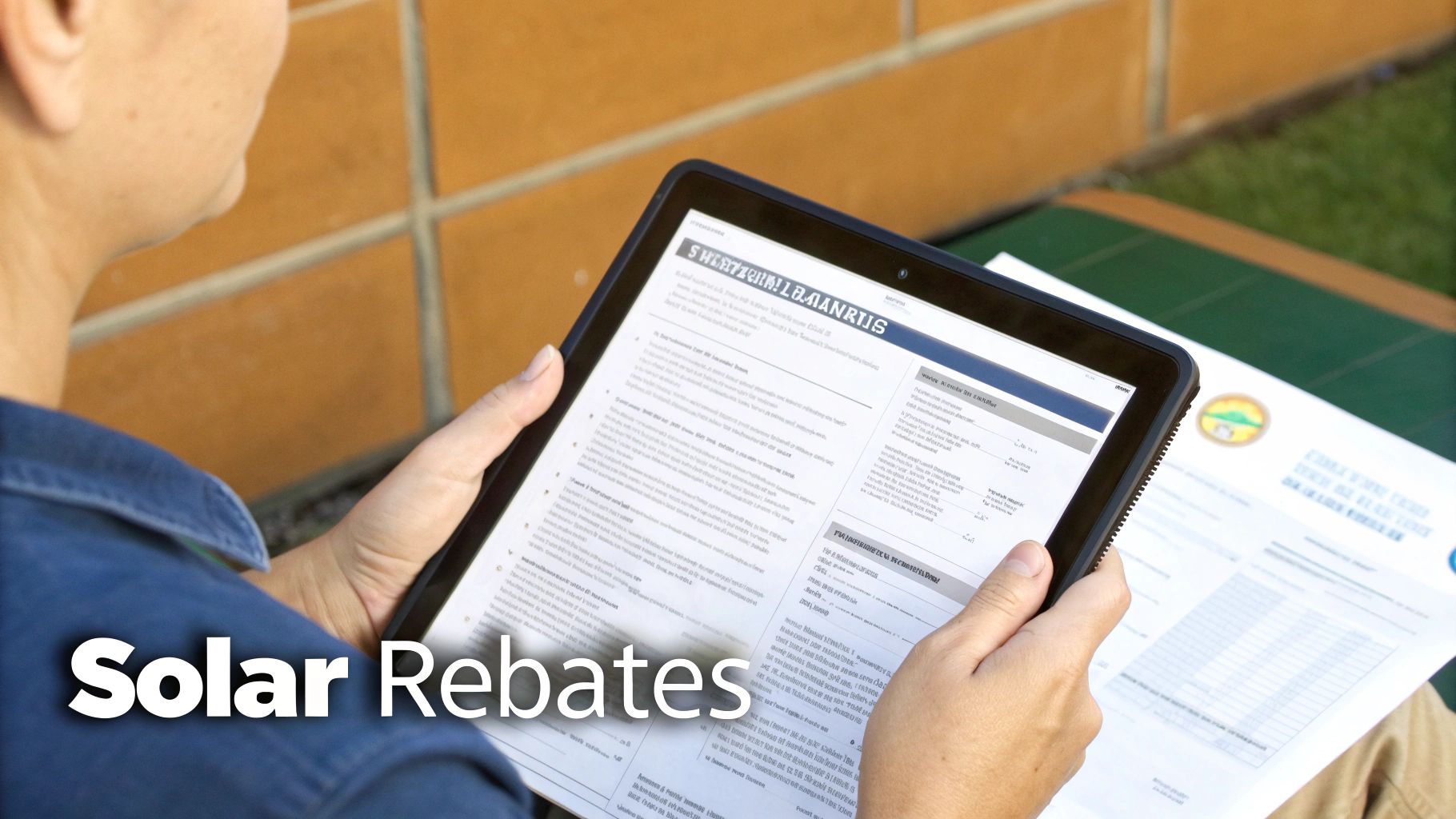
The sticker price for a solar installation is almost never what you actually end up paying. A whole suite of government and utility incentives exists to knock down that initial cost, making your savings even bigger. Think of it like stacking multiple coupons on a major purchase—each one chips away at the final price tag.
These financial perks are specifically designed to shorten your payback period and put solar within reach for more homeowners. When you take full advantage of them, you can slash thousands off your upfront investment and start enjoying pure savings much, much sooner.
The Federal Solar Tax Credit
The biggest and most widely available incentive for homeowners in the U.S. is the federal solar tax credit. It's officially called the Residential Clean Energy Credit, and it’s a game-changer. This isn't just a deduction; it's a true credit that directly reduces what you owe in federal income taxes, dollar for dollar.
Right now, the credit lets you subtract 30% of your total system cost from your federal tax bill. So, on a $20,000 system, that's a $6,000 credit coming straight back to you. Your net cost suddenly drops to just $14,000.
Staying on top of government programs is key. For the most current information, you can read up on federal solar and home energy tax credits to understand deadlines and who qualifies.
State and Local Programs
On top of the big federal credit, the savings often get even better at the local level. Many states, cities, and even your local utility company offer their own incentives. These can seriously lower your final solar panel installation costs and send your ROI soaring.
https://radiantenergysolar.com/solar-panel-installation-costs/
These local programs usually show up in a few different forms:
- State Tax Credits: Just like the federal one, but for your state income taxes. Some states let you "double-dip" with both.
- Cash Rebates: This is a straightforward check in the mail. Some programs offer a direct cash-back payment after your system is up and running.
- Performance-Based Incentives (PBIs): In some regions, you can actually earn money for the clean energy your panels generate. Programs like Solar Renewable Energy Certificates (SRECs) pay you for producing power.
Because these programs are so location-specific, a little homework goes a long way. It's absolutely worth researching what's available right in your backyard to make sure you're getting every last dollar of savings.
Tying Up the Loose Ends: Your Final Questions Answered
Even after running the numbers, a few practical questions always come up. Let's tackle the common ones that might be on your mind before you make the leap. Getting these details straight will give you a rock-solid understanding of what to expect from your solar investment.
Can Solar Panels Really Get Rid of My Electric Bill?
This is the big one, and the honest answer is: almost. While it's possible for some households to hit a net-zero balance over a year (meaning you produce as much energy as you consume), most people will still see a small bill.
Think of it this way: you’ll still be connected to the grid. Your utility company charges a small, non-bypassable monthly fee just to maintain that connection. So, while you can slash the part of your bill that pays for the actual electricity you use, that tiny service charge will likely remain. The goal is to dramatically reduce your bill, not necessarily make it vanish entirely.
What About Maintenance Costs and Batteries?
It's smart to wonder if upkeep will eat into your savings. The great news is that modern solar panels are built like tanks. They have no moving parts and are designed to withstand the elements for decades with little more than an occasional cleaning.
Plus, virtually all quality installations come with a 25-year warranty on the panels themselves. This gives you peace of mind that unexpected repair costs won't derail your financial returns down the road.
And what about adding a solar battery? A battery is like a personal energy piggy bank. It stores the extra solar power you generate during the day so you can use it at night or when the grid goes down.
While adding a battery increases the initial investment, it can seriously boost your savings, especially if your utility has high evening electricity rates or doesn't offer a great net metering program. It’s the key to maximizing your energy independence.
The Bottom Line: Going solar is all about slashing your energy expenses for the next 25+ years. You might still have a small grid connection fee, but the savings on your actual electricity usage are huge and incredibly consistent.
Answering these final questions helps put the full financial picture into focus, allowing you to move forward confidently.
Ready to see how much you could save with a system designed for your home? Radiant Energy offers high-quality solar solutions to help you achieve energy independence. Get your personalized solar quote today

